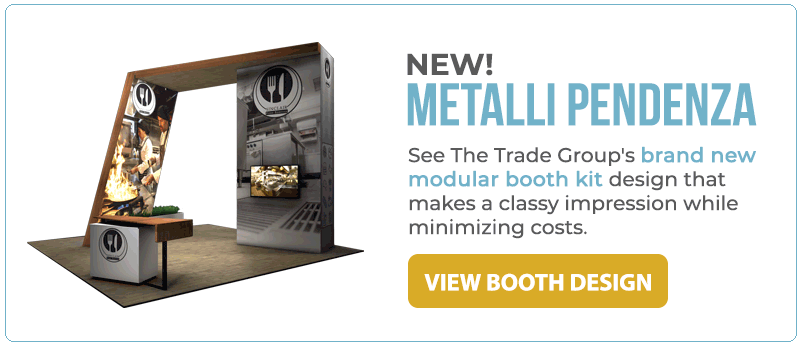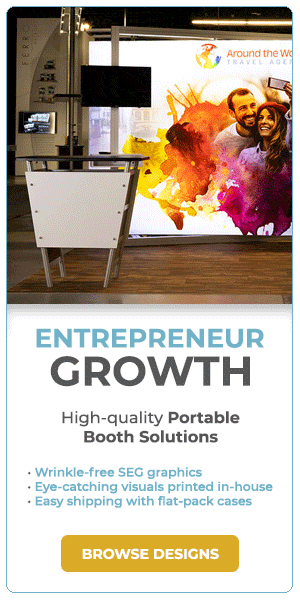
Wondering how to travel on a budget for trade shows? Believe us—you’re not alone! At some airlines, ticket prices are up by 25% due to rising fuel costs, pilot shortages, and low seating capacity. Right now, even the thriftiest of travelers are being tested. But if that’s the case, how much truer is it for the trade show director on a budget!
Right off the bat, the first thing to understand is that it IS possible to travel on a budget for a trade show. While you may not save as much money as you would, say, five years ago, many smart ways exist to cut costs today and keep your travel budget intact.
Currently, travel and lodging accounted for about 13% of overall trade show expenses. That’s the third largest expense. (If you’re wondering what the first two are, read here). Travel expenses for trade shows are typically divided into three categories:
- Transportation
- Lodging
- Meals
We will take a closer look at each of these and show how to prevent scope creep and stay on a travel budget.
Transportation expenses
A common mistake directors make when considering transportation expenses in a travel budget is only planning for the flight. But there are other kinds of transportation expenses to take into consideration, such as
- Flight tickets
- Airport parking
- Transportation to and from the airport, venue, hotel
This encompasses all modes of travel for you and your staff, from your base to your hotel and the trade show venue. Of course, air travel is a significant component, but don’t overlook transportation between the venue and accommodations, as well as parking fees.
Solutions for minimizing transportation costs
Whether it’s a taxi, Uber, or Lyft, transportation costs can accumulate rapidly, especially to and from the airport. Here are some ideas and tips for saving.
- Book flights early (between 2-8 months before departure)
- Ensure carry-on is included in the flight ticket
- Check if the hotel offers complimentary airport shuttles. If not, consider contracting a shuttle service, as a single trip may be more economical than multiple taxi rides
- Compare renting a limousine vs a shuttle service
- If extensive driving is required, consider renting a car might be the most budget-friendly option
- Carpool whenever possible
Planning a great travel budget for trade shows is all about shaving a few dollars here and there so that small savings add up to big bucks.

Lodging expenses
Hotels are also becoming increasingly expensive as they grapple with worker shortages. Thankfully, trade shows often negotiate discounted rates with nearby hotels for attendees—especially if the show is actually held in a hotel. If not, nearby accommodation may offer reduced rates for large groups.
Solutions for minimizing lodging costs
The last thing any trade show manager wants to see is travel costs exceed their already exorbitant place in the budget. Fortunately, you can keep costs down on lodging without having to ask your staff to bunk together like kids at summer camp. Just be sure to
- Figure out how many staff members are needed
- Take advantage of the early bird rate
- Ask for group discounts
- Compare nearby hotels that are within walking distance of the venue
- Consider hiring supplement staff who are from the city you’re traveling to
These simple best practices go a long way toward keeping you on budget.
Food expenses
This category covers meals and miscellaneous food items for you and your team, which can range from morning coffee to an evening bottle of water to a team dinner. Another important category to consider is networking meals, in which sales team members take prospects and customers out to dinner.
Solutions for minimizing food costs
There are a few options to explore when thinking about how to minimize meals. For starters, reference the list below.
- Set expectations in your pre-show meetings with staff
- Decide if there should be a per diem
- Figure out how many meals to be scheduled in advance, if any
- Ship waters with the exhibit
Keep in mind this is just a good start. These ideas are explored in greater detail below in case you’re wondering what a per diem is or what hiring supplemental staff for a show looks like.
More ideas for traveling on a budget for trade shows
Carefully plan for staffing needs
Overstaffing a booth is an easy error, as it’s often assumed that more is always better. While the truth of this statement varies, it’s never a good look to have a group of staff in branded attire leaning against display walls, absorbed in their phones. This appears unprofessional and deters potential visitors.
On the other hand, too few staff members can lead to missed opportunities and added stress, impairing their performance just when they need to excel. Trade show staff should be friendly, maintain eye contact, and possess extensive knowledge of your brand and products. Fatigued staff cannot meet these expectations.
A general rule for trade shows is to assign one staff member per 50 square feet of display space, plus one extra for breaks. To calculate this number, subtract all square footage occupied by merchandise displays and counters from your total exhibit footprint, then divide the remainder by 50.
Ultimately, determining the ideal balance of booth staff to space is up to you.
Consider hiring exhibition staff
While external staff cannot replace your knowledgeable employees, they can fill roles like greeters or raffle sign-up coordinators. Hiring temporary event staff for these positions can be more cost-effective than flying, housing, and feeding employees for several days.
Temporary trade show staff often excel at attracting attention and engaging with distracted attendees, increasing foot traffic through your display.

Retain staff only as long as needed
Trade shows, particularly multi-day events, have peak days. The final day is often less busy, with many attendees leaving early or not attending.
If you’ve observed this trend in your industry’s trade shows, consider allowing some staff members to leave early. While this won’t save on travel expenses, it can reduce hotel and meal costs for the last day.
Ensure you’re doing everything correctly, particularly with a new show, by checking with show management for average daily traffic patterns from past events.
Incentivize per diem
Providing a daily allotment for each staff member to spend on food, transportation, and other costs is a straightforward and effective way of establishing a cap on employee spending. Your staff cannot go over budget because they have no access to additional funds.
However, the only way for that money to go back into your budget is for the staff not to spend it, and there is no reason to think your team won’t spend that money. If someone has $50 left near the end of the day, they lose it if they don’t spend it. They’re getting the steak and a nice glass of wine or two.
Instead, consider implementing a program where your employees earn a bonus for the unspent portion of their per diem. For example, an employee is given $75 to spend every day for a six-day show. At the show’s end, the employee only spent $300, leaving a remainder of $150. If you split that money with the employee, they have $75 to spend however they wish, and you can add some green to your ledger. It’s a relatively small gesture that can help to boost morale and cushion your budget a bit.
Schedule group meals
Another option is to forego per diem and schedule mealtimes with your staff. This allows you to control spending by selecting the location and setting spending limits, such as a maximum entrée cost or limiting the number of alcoholic drinks.
These meals can also be an opportunity to discuss successes, areas for improvement, and goals for the next day.

Conclusion
Preventing budget overruns involves trimming small expenses here and there, allowing minor savings to accumulate into significant amounts. For more advice on cost-saving strategies while traveling to a show or for any other trade show inquiries, feel free to contact The Trade Group at 800-343-2005.
Photo credit: Pexels




